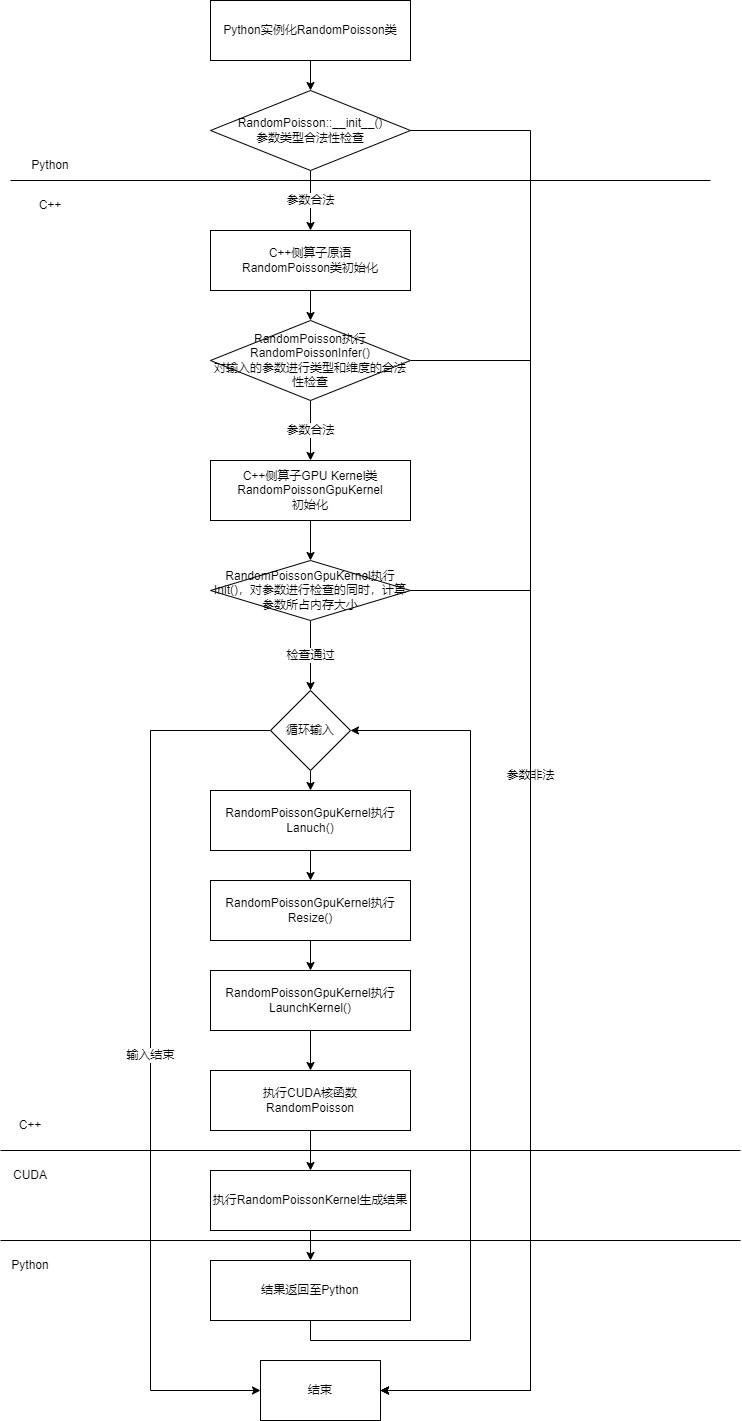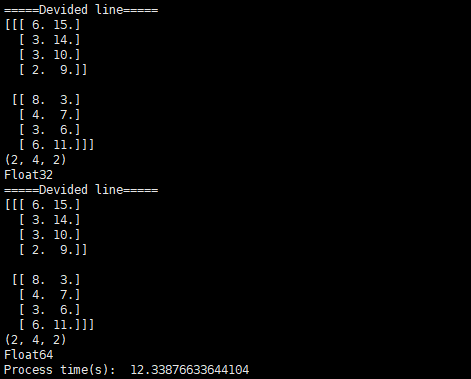1
2
3
4
5
6
7
8
9
10
11
12
13
14
15
16
17
18
19
20
21
22
23
24
25
26
27
28
29
30
31
32
33
34
35
36
37
38
39
40
41
42
43
44
45
46
47
48
49
50
51
52
53
54
55
56
57
58
59
60
61
62
63
64
65
66
67
68
69
70
71
72
73
74
75
76
77
78
79
80
81
82
83
84
85
86
87
88
89
90
91
92
93
94
95
96
97
98
99
100
101
102
103
104
105
106
107
108
109
110
111
112
113
114
115
116
117
118
119
120
121
122
123
124
125
126
127
128
129
130
131
132
133
134
135
136
137
138
139
140
141
142
143
144
145
146
147
|
#include "plugin/device/gpu/kernel/random/random_poisson_gpu_kernel.h"
#include <functional>
#include <utility>
#include <memory>
#include <string>
#include <algorithm>
#include "ir/anf.h"
#include "utils/log_adapter.h"
#include "kernel/common_utils.h"
#include "include/cuda_fp16.h"
namespace mindspore {
namespace kernel {
namespace {
using KernelRunFunc = RandomPoissonGpuKernelMod::KernelRunFunc;
#define ADD_KERNEL(shape_dtype, rate_dtype, output_dtype, rate_type, output_type) \
{ \
KernelAttr() \
.AddInputAttr(kNumberType##shape_dtype) \
.AddInputAttr(kNumberType##rate_dtype) \
.AddOutputAttr(kNumberType##output_dtype), \
&RandomPoissonGpuKernelMod::LaunchKernel<rate_type, output_type> \
}
}
bool RandomPoissonGpuKernelMod::Init(const BaseOperatorPtr &base_operator, const std::vector<KernelTensorPtr> &inputs,
const std::vector<KernelTensorPtr> &outputs) {
MS_EXCEPTION_IF_NULL(base_operator);
kernel_name_ = base_operator->name();
if (!MatchKernelFunc(base_operator, inputs, outputs)) {
return false;
}
auto kernel_attr = GetKernelAttrFromTensors(inputs, outputs);
unit_shape_size_ = abstract::TypeIdSize(kernel_attr.GetInputAttr(0).first);
unit_rate_size_ = abstract::TypeIdSize(kernel_attr.GetInputAttr(1).first);
unit_output_size_ = abstract::TypeIdSize(kernel_attr.GetOutputAttr(0).first);
auto kernel_ptr = std::make_shared<ops::RandomPoisson>(base_operator->GetPrim());
seed_ = static_cast<int64_t>(kernel_ptr->get_seed());
seed2_ = static_cast<int64_t>(kernel_ptr->get_seed2());
return true;
}
int RandomPoissonGpuKernelMod::Resize(const BaseOperatorPtr &base_operator, const std::vector<KernelTensorPtr> &inputs,
const std::vector<KernelTensorPtr> &outputs,
const std::map<uint32_t, tensor::TensorPtr> &) {
for (const auto &input : inputs) {
auto input_shape = input->GetShapeVector();
if (!IsValidShape(input_shape)) {
return KRET_UNKNOWN_SHAPE;
}
}
ResetResource();
std::vector<int64_t> shape_shape = std::vector<int64_t>(inputs.at(kIndex0)->GetDeviceShapeAdaptively().begin(),
inputs.at(kIndex0)->GetDeviceShapeAdaptively().end());
std::vector<int64_t> rate_shape = std::vector<int64_t>(inputs.at(kIndex1)->GetDeviceShapeAdaptively().begin(),
inputs.at(kIndex1)->GetDeviceShapeAdaptively().end());
std::vector<int64_t> output_shape = std::vector<int64_t>(outputs.at(kIndex0)->GetDeviceShapeAdaptively().begin(),
outputs.at(kIndex0)->GetDeviceShapeAdaptively().end());
int64_t shape_elements = std::accumulate(shape_shape.begin(), shape_shape.end(), 1, std::multiplies<int64_t>());
rate_elements_ = std::accumulate(rate_shape.begin(), rate_shape.end(), 1, std::multiplies<int64_t>());
output_elements_ = std::accumulate(output_shape.begin(), output_shape.end(), 1, std::multiplies<int64_t>());
if (output_elements_ == 0) {
is_null_input_ = true;
}
input_size_list_.emplace_back(shape_elements * unit_shape_size_);
input_size_list_.emplace_back(rate_elements_ * unit_rate_size_);
output_size_list_.emplace_back(output_elements_ * unit_output_size_);
workspace_size_list_.push_back(output_elements_ * sizeof(curandState));
return KRET_OK;
}
template <typename R, typename T>
bool RandomPoissonGpuKernelMod::LaunchKernel(const std::vector<kernel::AddressPtr> &inputs,
const std::vector<AddressPtr> &workspace,
const std::vector<kernel::AddressPtr> &outputs) {
R *rate_addr = GetDeviceAddress<R>(inputs, 1);
T *output = GetDeviceAddress<T>(outputs, 0);
curandState *devStates = nullptr;
void *workspace_addr = GetDeviceAddress<void *>(workspace, 0);
devStates = reinterpret_cast<curandState *>(workspace_addr);
RandomPoisson(seed_, seed2_, devStates, rate_addr, rate_elements_, output, output_elements_,
reinterpret_cast<cudaStream_t>(cuda_stream_));
return true;
}
const std::vector<std::pair<KernelAttr, KernelRunFunc>> &RandomPoissonGpuKernelMod::GetFuncList() const {
static const std::vector<std::pair<KernelAttr, KernelRunFunc>> func_list = {
ADD_KERNEL(Int32, Float16, Float16, half, half), ADD_KERNEL(Int32, Float16, Float32, half, float),
ADD_KERNEL(Int32, Float16, Float64, half, double), ADD_KERNEL(Int32, Float16, Int32, half, int),
ADD_KERNEL(Int32, Float16, Int64, half, int64_t),
ADD_KERNEL(Int32, Float32, Float16, float, half), ADD_KERNEL(Int32, Float32, Float32, float, float),
ADD_KERNEL(Int32, Float32, Float64, float, double), ADD_KERNEL(Int32, Float32, Int32, float, int),
ADD_KERNEL(Int32, Float32, Int64, float, int64_t),
ADD_KERNEL(Int32, Float64, Float16, double, half), ADD_KERNEL(Int32, Float64, Float32, double, float),
ADD_KERNEL(Int32, Float64, Float64, double, double), ADD_KERNEL(Int32, Float64, Int32, double, int),
ADD_KERNEL(Int32, Float64, Int64, double, int64_t),
ADD_KERNEL(Int32, Int32, Float16, int, half), ADD_KERNEL(Int32, Int32, Float32, int, float),
ADD_KERNEL(Int32, Int32, Float64, int, double), ADD_KERNEL(Int32, Int32, Int32, int, int),
ADD_KERNEL(Int32, Int32, Int64, int, int64_t),
ADD_KERNEL(Int32, Int64, Float16, int64_t, half), ADD_KERNEL(Int32, Int64, Float32, int64_t, float),
ADD_KERNEL(Int32, Int64, Float64, int64_t, double), ADD_KERNEL(Int32, Int64, Int32, int64_t, int),
ADD_KERNEL(Int32, Int64, Int64, int64_t, int64_t),
ADD_KERNEL(Int64, Float16, Float16, half, half), ADD_KERNEL(Int64, Float16, Float32, half, float),
ADD_KERNEL(Int64, Float16, Float64, half, double), ADD_KERNEL(Int64, Float16, Int32, half, int),
ADD_KERNEL(Int64, Float16, Int64, half, int64_t),
ADD_KERNEL(Int64, Float32, Float16, float, half), ADD_KERNEL(Int64, Float32, Float32, float, float),
ADD_KERNEL(Int64, Float32, Float64, float, double), ADD_KERNEL(Int64, Float32, Int32, float, int),
ADD_KERNEL(Int64, Float32, Int64, float, int64_t),
ADD_KERNEL(Int64, Float64, Float16, double, half), ADD_KERNEL(Int64, Float64, Float32, double, float),
ADD_KERNEL(Int64, Float64, Float64, double, double), ADD_KERNEL(Int64, Float64, Int32, double, int),
ADD_KERNEL(Int64, Float64, Int64, double, int64_t),
ADD_KERNEL(Int64, Int32, Float16, int, half), ADD_KERNEL(Int64, Int32, Float32, int, float),
ADD_KERNEL(Int64, Int32, Float64, int, double), ADD_KERNEL(Int64, Int32, Int32, int, int),
ADD_KERNEL(Int64, Int32, Int64, int, int64_t),
ADD_KERNEL(Int64, Int64, Float16, int64_t, half), ADD_KERNEL(Int64, Int64, Float32, int64_t, float),
ADD_KERNEL(Int64, Int64, Float64, int64_t, double), ADD_KERNEL(Int64, Int64, Int32, int64_t, int),
ADD_KERNEL(Int64, Int64, Int64, int64_t, int64_t)};
return func_list;
}
MS_KERNEL_FACTORY_REG(NativeGpuKernelMod, RandomPoisson, RandomPoissonGpuKernelMod);
}
}
|

